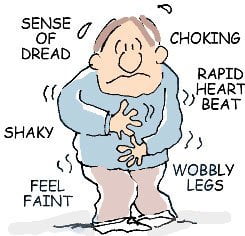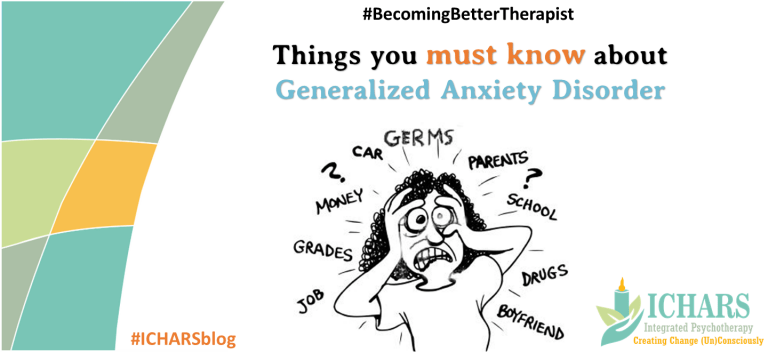Introduction
In this post, we will focus on Generalized Anxiety Disorder (GAD):
- What is it?
- What are its causes and symptoms?
- What steps can therapists take to help clients deal with it effectively?

GAD, as encapsulated in the Diagnostic and Statistical Manual (DSM) of mental disorders, manifests as a pervasive sense of anxiety, transcending specific triggers to permeate daily life.
Understanding GAD
Anxiety is a global response comprising of emotional, cognitive and physiological components wherein the person feels paramount fear under certain circumstances or of certain things and would go to great extents to avoid the same. Just the prospect of facing an unpleasant, undesirable situation would trigger this extremely fearful response and would cause behavioural disturbances.
For some people, this fear is confined to very specific stimuli such as dogs or spiders. However, for still others, the dark cloud of anxiety seems to follow them almost everywhere they go. When the person can’t clearly place a finger on what triggers their anxiety response, they may be said to have GAD.
People with GAD, don’t experience tension and worry associated with a particular object or event. Rather, worry becomes a general state of mind in their day-to-day existence.
Symptoms of Generalized Anxiety Disorder:

The symptoms of this disorder may include
- A general sense of restlessness—being unable to settle down and relax.
- Sleep disturbances which may include an inability to sleep (insomnia), difficulty falling asleep or staying asleep.
- Constant feelings of being drained of all energy due to over-the-top efforts made to preserve safety.
- Irritability caused by the inability to control all possible sources of anxiety.
- Muscle tension stemming from the body being in the constant fight-or-flight mode.
- Difficulty to concentrate on the task at hand due to the constant mind-wandering about how everything could possibly go wrong.
- Indecisiveness due to humongous amount of time spent on thinking things over and over again.
- Headaches, fidgeting, indigestion and strained face.
Since most of us don’t understand that this anxiety ridden persona is in fact an indicator of a mental illness, those who suffer from GAD often mistake their symptoms as being signs of them “going crazy” or having a heart attack.
Co-morbidity and Generalized Anxiety Disorder

Often GAD is accompanied by other disorders like alcohol addiction and depression. This is because, alcohol helps individuals with GAD to take the “edge off” their anxious mood and so many self-medicate to the point of abuse.
Similarly, depression tends to co-occur with GAD because their fear of everything makes them withdraw from many enjoyable activities. Also, their social interactions are hampered by their persistently worrying nature which might be viewed as ‘frustratingly boring and fun-spoiling’ by many of us.
Thus, when treating GAD, the co-morbidity of these conditions must be addressed too.
Causes of Generalized Anxiety Disorder
The ‘why’ behind the ‘what’ of this disorder can be explained from biological, psychological and sociological perspectives.
- Biologically speaking, GAD can be caused due to disturbances in the levels of neurotransmitters like Gamma-Aminobutyric Acid (GABA), serotonin and norepinephrine. Besides, research has found that people prone to developing this disorder inherit a neurotic personality style i.e. they tend to be high on emotional instability and predominantly experience negative feelings.
Thus, anti-anxiety medication to control abnormally high levels of arousal provoking neurotransmitters may be used to bring GAD under control. - However, biology is often combined with societal stressors that might aggravate the mental health condition. Individuals living a fast-moving, stressful life combined with poor diet habits are more likely to develop the physiological symptoms of GAD.
- Also, the biological inheritability of GAD is more likely to show when one is exposed to a set of parents who themselves exhibit irrational worrying behaviours. In a way, it is actually possible to “rub off” your tense vibe onto someone else. Moreover, childhood sexual abuse may be another triggering point for GAD.
- From the psychological viewpoint, GAD is rooted in cognitive distortions i.e. incorrect thought patterns. It is believed that individuals with GAD have a very low stress tolerance level and display catastrophizing tendencies. Thus, exposure to a minor nuisance like breaking down of a kitchen appliance might get them worked up.
They become extensively apprehensive and expect the worst to happen. Slowly, their worry shifts from their actual problem to their anxious behaviour itself i.e. they start having anxieties about their anxieties.
As a result of this ever-increasing mountain of anxiety, they make more mistakes because of which they are less efficient at whatever chores they do. Not being up to the mark only adds to their stress. - Compounding the issue is their lack of self-confidence. They strongly believe that they don’t have it in them to stop their uncontrollable thoughts that trigger worrying.
Generalized anxiety disorder peaks around middle age and declines with time as life becomes a little less stressful. However, don’t we all want to live the prime of our life being loved for who we are, respected for what we do, having a good laugh with friends and succeeding to achieve our full potential?
A person with GAD also wants the same things that all of us desire but an invisible force stops them back from achieving it all.
Therapists Niche
We highly recommend that a therapist use an eclectic approach to help client deal with GAD.
Steps based on an Eclectic Approach to help clients with deal with Generalized Anxiety Disorder
- Work with thought patterns:
- Identify the worry-stricken thought patterns and the automatic strategies that the mind seems to follow to generate anxiety
- Find alternative thought patterns and strategies that can be used to replace or restructure the worry-stricken thought patterns and strategies
- Replace or restructure the thoughts and strategies with the help of techniques like if / then statement, thought stopping, gradual exposure to anxiety provoking stimuli, submodalities…
- Work with Skills and Emotions:
- Develop self confidence initially through positive suggestions and reinforcements.
- Learn processes and techniques for self relaxation
- Develop skills and apply the same to be able to handle and address anxiety provoking stimuli more confidently and calmly
- Work with deeper issues (if required):
- Identify deeper issues that are the cause of anxiety. Hypnotic metaphors and de-layering techniques like Corrective therapy, Emotional Empowerment Technique… can be very effective for this.Inner child work or Regression therapy can be used to help clients deal with the identified deeper issues.Identify and Deal with co-morbid issues
We have found that a modified version of the Radical Trance-formational Metaphor process covered during the Level 2 of the Cognitive Hypnotic Psychotherapy Program is highly effective to help clients get quick relief from Generalized Anxiety. This has been one process that was originally conceptualized by us to be used during coaching sessions. Even we were surprised by its effectiveness when we used it with GAD clients.
Notes for therapists when working with Generalized Anxiety Disorder:
- Any psycho-therapeutic treatment is not a replacement for psychiatric treatment. The two must work in combination with one another. Hence, in case of any disorder, it is very important for the psychotherapist to work in consultation with a psychiatrist.
- Suggesting relaxation to a person who suffers from anxiety can make them even more anxious. Using conversational hypnosis in such situations is generally seen to be safer and more effective.
- Regression in any form must be used very carefully and only after the intensity of the anxiety and the symptoms have reduced considerably. Also it is not necessary to use regression as many times certain hypnotic metaphors can achieve the same outcome.
If you are a mental health practitioner who would like to use an eclectic approach to work with clients, you would really love the Cognitive Hypnotic Psychotherapy™ Program. It is a comprehensive course based on the integration of cognitive, behavioural and psychodynamic approaches with Clinical Hypnosis, Neuro Linguistic Programming, Mindfulness and Metaphor Therapy

